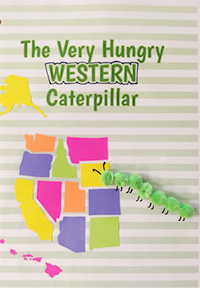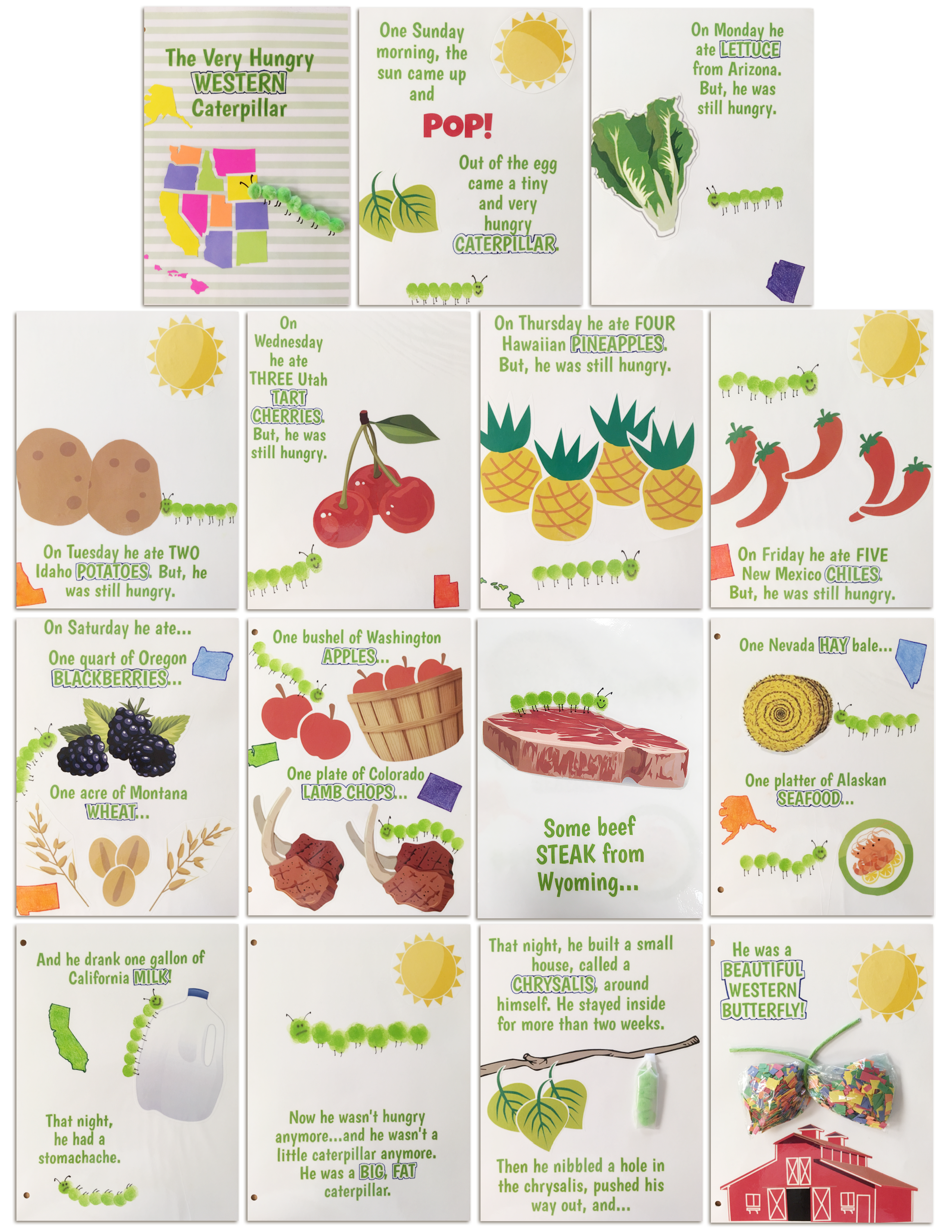 Relevancy and Engagement
massachusetts.agclassroom.org
Relevancy and Engagement
massachusetts.agclassroom.org

The Very Hungry Western Caterpillar
Based off of Eric Carle's The Very Hungry Caterpillar, this caterpillar takes a journey through the Western United States as he eats some of the most popular agriculture commodities in each state. This book can be made individually by students or used as a classroom copy.
Time to Complete
3-4 hours
Materials
Per book:
- 1 copy of Western States Hungry Caterpillar story (pages 1-16 of attached PDF)
- 1 copy of Western States Hungry Caterpillar printable pictures (pages 17-31 of attached PDF)
- 12 green pompoms (caterpillars for cover page and page 12)
- 1 small white bead or small white folded piece of paper (egg for page 1)
- 2 x 4" piece of clear plastic wrap (chrysalis for page 12)
- 1 snack-sized sandwich bag (butterfly on page 13)
- 1 pipe cleaner (body and antenna for butterfly on page 13)
- Colorful paper/confetti (to place inside sandwich bag for butterfly body on page 13)
- Colored inkpad for thumbprints
- Various art supplies (colored pencils, markers, glue, scissors)
- 3 binder clips/rings to assemble book
Procedures
- Determine if your students will be completing this project individually or as a class. If printing all the story pages and printable pictures in color is not an option, the following options can be used to assemble this book:
- Students can draw and illustrate their own pictures on each page.
- The printables can be printed in grey-scale for students to color.
- Each student can be assigned his/her own page to design and color to make a single classroom set. Remind students to leave room on each page for the fingerprint caterpillar.
- Have students decorate each page of the story using the printable pictures. Each of the pictures can be found in order with a note of what page they belong on. Note that the Western states (on the cover) can be cut up individually as seen in the example below, or left intact.
- Have students create their fingerprint caterpillars on each page by using their thumb pressed in ink. A face can be drawn on each caterpillar using a fine-point marker or pen.
- Note: If you would like the book to be laminated for long-term use and durability, the book should be laminated right now before the book is assembled and the 3D materials are attached.
- Attach the pompoms to the cover page to create a 3D caterpillar. The pompoms can be attached to the book using glue sticks. Add feet and antennae to the caterpillar using a fine-point marker/pen.
- On page 1, attach the white bead or folded piece of paper (egg) to the leaf.
- On page 14, the caterpillar will need to be assembled and wrapped in the plastic clear wrap. (The plastic clear wrap will represent the chrysalis.) Cut up the plastic clear wrap into a 2 inch by 4 inch rectangle. Line up the pompoms on the clear wrap and roll them up inside. Glue the chrysalis shut and attach to the page on the tree branch.
- Fill up the snack-sized sandwich baggie with confetti or colored paper cut into small pieces/strips. Seal the sandwich baggie shut and make sure all the air is pressed out. Pinch the middle of the sandwich baggie to create a bow shape. This bow shape should resemble the body/wings of a butterfly. Wrap the pipe cleaner around the pinched section to create the body and antennae of the butterfly body. Attach the colorful butterfly to the last page using glue or tape.
- As a final step, assemble the book by punching 3 holes in each page and attaching together with binder clips or rings.

File, Map, or Graphic
Author
Utah Agriculture in the Classroom
Sources
This story was adapted from Eric Carle's original book, The Very Hungry Caterpillar.